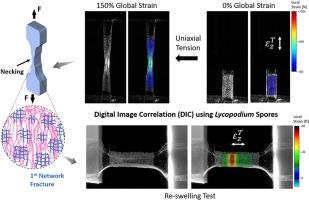韧性双网状水凝胶的变形与断裂表征
IF 4.5
2区 化学
Q2 POLYMER SCIENCE
引用次数: 0
摘要
双网状水凝胶(dnh)的显著韧性来自于较硬的第一网络变形破坏所导致的能量耗散,而较软的第二网络保持了样品的整体完整性。本研究开发了一种适用于dnh应变场分析的新方法,即在光滑的水凝胶表面上引入石松孢子,形成坚固的斑点图案。因此,数字图像相关(DIC)方法适用于机械变形过程中的局部应变场分析,即拉伸测试,表现出非均匀变形,例如颈缩过程。此外,再膨胀实验中的应变场分析,一种直观有效的技术,可以可视化和表征dnh在颈缩过程中形成的预拉伸区,已经得到了改进。这种基于dic的分析在液体中进行,为dnh内部裂缝分析提供了一种创新和补充的方法,不需要复杂的后处理、昂贵的仪器或复杂的化学反应,并且可以更深入地了解dnh中以第一网络裂缝为主的不可逆损伤所导致的裂缝。本文章由计算机程序翻译,如有差异,请以英文原文为准。

Characterization of the Deformation and Fracture of Tough Double-Network Hydrogels
The remarkable toughness of double-network hydrogels (DNHs) arise from the energy dissipation due to the deformation-induced failure of the stiffer first network, while the softer second network maintains the sample’s overall integrity. In this study, a new approach for strain field analysis suitable for DNHs has been developed by introducing lycopodium spores to create robust speckle patterns on the slippery hydrogel surface. Thus, digital image correlation (DIC) method was feasible for localized strain field analysis during mechanical deformation, i.e. tensile testing, exhibiting inhomogeneous deformation, e.g. during necking. Further, strain field analysis during re-swelling experiments, a straightforward and effective technique to visualize and characterize pre-stretched zones formed during necking in DNHs, has been improved. This DIC-based analysis, performed in a liquid, offers an innovative and complementary approach for internal fracture analysis of DNHs, without requiring complex post-processing, expensive instrumentation or sophisticated chemistry, and provides a deeper understanding of fracture resulting from irreversible damage in DNHs, which is dominated by first-network fracture.
求助全文
通过发布文献求助,成功后即可免费获取论文全文。
去求助
来源期刊

Polymer
化学-高分子科学
CiteScore
7.90
自引率
8.70%
发文量
959
审稿时长
32 days
期刊介绍:
Polymer is an interdisciplinary journal dedicated to publishing innovative and significant advances in Polymer Physics, Chemistry and Technology. We welcome submissions on polymer hybrids, nanocomposites, characterisation and self-assembly. Polymer also publishes work on the technological application of polymers in energy and optoelectronics.
The main scope is covered but not limited to the following core areas:
Polymer Materials
Nanocomposites and hybrid nanomaterials
Polymer blends, films, fibres, networks and porous materials
Physical Characterization
Characterisation, modelling and simulation* of molecular and materials properties in bulk, solution, and thin films
Polymer Engineering
Advanced multiscale processing methods
Polymer Synthesis, Modification and Self-assembly
Including designer polymer architectures, mechanisms and kinetics, and supramolecular polymerization
Technological Applications
Polymers for energy generation and storage
Polymer membranes for separation technology
Polymers for opto- and microelectronics.
 求助内容:
求助内容: 应助结果提醒方式:
应助结果提醒方式:


